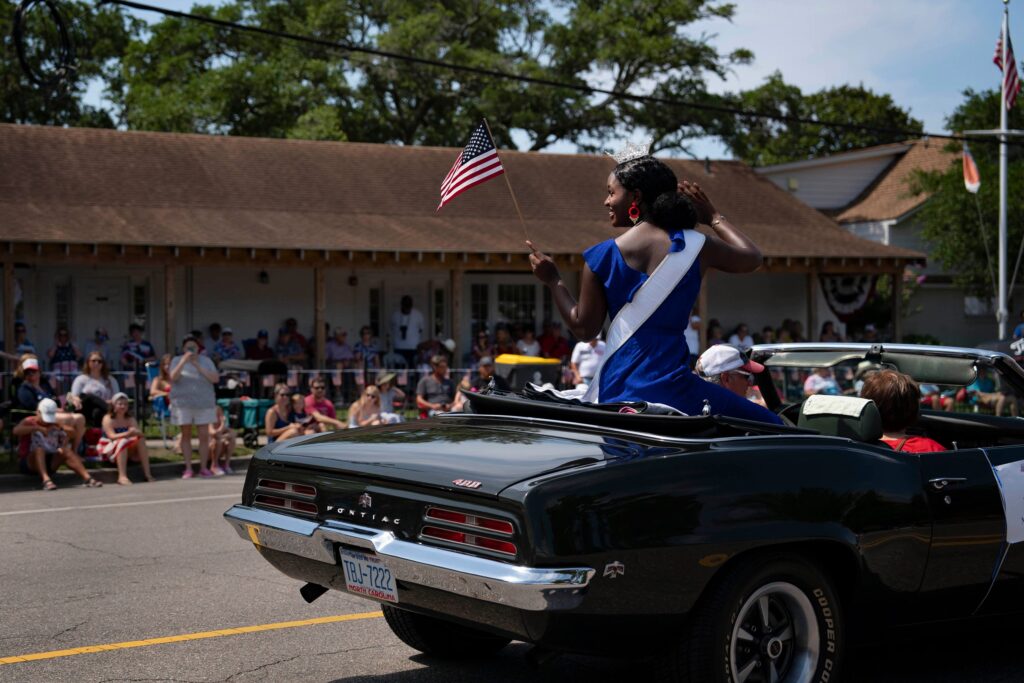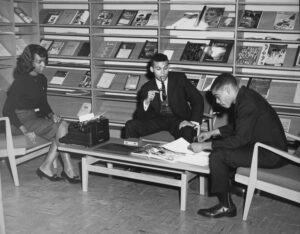Undecided in America

The front lawn of the small bungalow where Jessie lives with her wife and daughter is freshly mowed. Two vehicles are parked in the driveway: a pick-up truck and a small silver Pontiac. A few loose tools lie on the Pontiac’s trunk. Its back fender and the truck’s thin rocker panels are rusted, casualties of winters in northwest Wisconsin.
But it’s summer right now, and as Jessie and I talk swarms of gnats clog the air between us. They “get in everybody’s personal space,” she says nonchalantly. She’s 27, her wife is 32. They were married in 2018 under a large oak tree overlooking Memory Lake, within spitting distance of the bungalow.
Every July, Memory Lake is the site of a major championship in which snowmobiles are raced across the water. For one weekend a year it brings 100 participants and thousands of spectators to Grantsburg, Wisconsin, population: 1,350. This year’s event came on the heels of one of the wettest Junes in state history. When I visited Grantsburg the following weekend, it had the quiet look of a place swept clean by departed workers and volunteers. The blazing heat was back, bringing the clouds of gnats. Ever-present and in your face.
Politics felt that way, too, in the leadup to one of the most electrifying presidential elections in U.S. history.
Jessie was wearing a ball cap over a punk haircut, shaved on the sides and spikey on top. She had neon-orange tunnel earrings, circling dime-size lobe holes like the rings of an eclipse. After Jessie and her wife got married, they bought a pride flag and hung it outside their home. Nothing happened at first. Then it was torn down. For about a year they hesitated about doing anything that would make their home conspicuous again.
“Then we got a bigger flag,” Jessie said. “We got a new yard sign.” Both the flag and the sign are rainbow-colored, and neither has been touched since. “I’m very thankful for that,” she said. I’m struck by her graciousness. Some people see physical safety as an entitlement; others like Jessie, an openly gay woman in a conservative, religious area, are forced to see it as respite.
Jessie works as a material handler at Parker Hannifin, a large producer of coupling parts based in Minneapolis with plants in Grantsburg and Chetek, Wisconsin, and in Union City, Pennsylvania. Couplings are mechanical hub parts that connect shafts, helping transmit energy. Parker Hannifin’s are used on lift trucks and in “gas stations—or petrol stations,” Jessie tells me. “So if there happened to be a fire, those lines kind of seal themselves so it can’t cause more damage.”
I notice how Jessie adds “petrol station” after “gas station” to make sure I understand her, seeing as I am Canadian and live in England. She speaks with earnest courtesy, with a politeness I’ve found frequently in the dozens of interviews I’ve been carrying out across different states.
The route I’m taking roughly follows the journey across the United States that Alexis de Tocqueville described in his classic book Democracy in America. In 1831, when he set off from Europe by ship with his traveling companion Gustave de Beaumont, there were 24 states in the union and the two men passed through more than half of those during their nine-month journey.
My study reexamines Tocqueville’s main themes: the role of commerce in the nation, tyranny by a majority, how political elites treat less powerful groups. And, of course, his overarching question: Will democracy survive in the future? These issues are as important today as they were then, if not more so given the U.S.’s superpower status. It’s the master domino; if its democracy topples, authoritarianism threatens to root even more deeply across the world.
Tocqueville and I are both foreigners. He felt that being French gave him an interpretative edge and the ability to see beyond “the perpetual practice of self-applause” he witnessed in the U.S.: “… there are certain truths which the Americans can only learn from strangers.” I agree outsiders can have an observational advantage, but I’m encountering a lot less self-applause than he did. Sixty-five interviews into my study, I find that the people I meet are anxious about the future of their nation. They want answers, new ideas.
There are other differences. I’m covering more territory than Tocqueville did because of how much larger the U.S. is today, planning interviews in the northeast (Ohio, Pennsylvania, Maine), the southeast (Florida, Louisiana, South Carolina), the northwest (Oregon, Montana, Washington), and the southwest (Nevada, Arizona, and California). I often decide where to go next based on word of mouth. “Grantsburg is where you’ll see the real America,” someone in Florida had suggested to me a few months earlier. He said I’d meet people struggling on low incomes and who have “heart”: people who care about their community. So I went there.
Even a large qualitative study—I have planned hundreds of interviews—captures only slivers of American life. But I have been seeing slivers that matter, slivers that break skin and expose people’s pain.
In Hinckley, Minnesota, a card dealer, 58, at the Grand Casino lets me take a selfie of us, then motions for me to put my phone away before the casino pit boss notices: no phones at card tables. We’re alone, so she talks—she wants to talk. I find that a lot: people pouring out words, as if they’ve been waiting a long while for this discussion.
She says she’s worried about the future of the nation. She wants more Christianity in classrooms; she thinks that would help children. “They let kids pretend they’re a cat. Why can’t they be allowed God?”
Despair is leading to an epidemic of suicides, she says. “You’ve seen this personally?” I ask. Yes. One evening her daughter, who had just turned 30, came over for dinner and the next day took her life. “She visits me, though—so that helps,” the dealer murmurs to me. “She comes to me in my dreams.” In one of those dreams her daughter whispered: “I’m sorry.” The dealer tried to hold her and to console her. “I told her: Now listen, it’s not your fault. This world wasn’t worth staying for.”
She is planning to vote for Donald Trump: She sees him as a strong president who’ll put Americans first, who’ll create the type of world her daughter could have thrived in. Other people I interviewed in Wisconsin and Minnesota disagree.
Margaret, 66, from St. Paul, Minnesota, popped by the Grand Casino to play the Keno machines after visiting her brother who lives a 35-minute drive away. The casino had comped her in the mail a $25 gift certificate to a nearby gas station. Margaret made $400 during her first ten minutes of gambling. Then she lost $200; then she spent $200. She was walking out even. That’s why, she said, she makes a point of not coming too often and not staying that long.
“If you’re here and you win right away, leave!” She laughs. “Are people hopeful things might get a little bit better after November 5th?” I ask. “No, not at all.” Why not? “I hate Trump. I just can’t stand him. He reminds me of Putin. He just wants to be king of the world.” When it comes to “poor people,” as she refers to herself, he’ll only make life worse. “Let’s just say Trump’s more for the rich.”
Why don’t more people see through him? “Just because they want change. Things haven’t been good for them.”
The card dealer is firmly Republican. Margaret is firmly Democrat.
But at least half the people I spoke with over four days near the Minnesota–Wisconsin border were swing voters. Like Billy, a former manager at the Hinckley Grand Casino who now drives trucks for BNSF Railway, one of North America’s largest freight rail companies.
“I don’t feel like I have a candidate,” he told me. When I interviewed him, President Joe Biden had just stepped aside and endorsed Vice President Kamala Harris as the Democrats’ candidate for president in November. Billy chaffed at how Biden’s tenure was being romanticized in the aftermath of the endorsement announcement. “I read today an email from our union praising how Joe Biden was the best president for unions in all of history.”
He thought: “What?” In December 2022, Biden approved legislation blocking rail workers from striking. For Billy, this was a betrayal. “I’m a railway worker. The train crews were on the verge of striking. Just for more time off—that’s what they were fighting for. He basically shot them down.”
Jessie, too, was undecided about how to vote in November. “I’ve definitely voted red in the past,” she told me. “I’ve definitely voted blue in the past.”
Both Jessie’s wife and her stepfather also work at Parker Hannifin. He’s a machinist, who turns 12-foot metal bars into six-inch components. Jessie works the day shift and her wife works nights so their 11-year-old always has a parent at home. Jessie studies in any spare time, for a degree in operations management and business at Pine Technical, a community college an hour south of Grantsburg.
“My salary for a given year is close to $46,000,” Jessie says. The family struggles. They shop carefully for school supplies and make the most of tax exemptions in Minnesota. “When we do shopping in Wisconsin, mostly it’s groceries,” she says. “If we do clothing, most of the time we go to Minnesota. Because at some points in time, those taxes just get to be a little painful.”
They sometimes rely on food drives and donate back any unused cans. They shop for bigger items in thrift stores and at garage sales. “It gives us a little bit extra in case something were to happen,” she says. “Like, the vehicle goes down.”
For Jessie, a key priority come November is which party will help lower-to-middle-income families like her own. “Right now I’m liking Kamala,” Jessie told me in late July. But she also felt that Trump had done good things. She singled out his approach to taxes and healthcare. I heard similar points a lot in my interviews: Trump has seemed fiercer in condemning high prescription-drug costs than any president in memory.
At first, Trump’s NAFTA renegotiations offered major concessions to the largest, most profitable pharmaceutical companies in the world, and they would have helped Big Pharma thwart competition from producers of generic drugs. The Democrats attacked. Senator Elizabeth Warren said in 2018 that Trump’s proposal was “stuffed with handouts that will let big drug companies lock in the high prices they charge for many drugs.”
Then Trump switched tack. He forced Big Pharma back to the table and got a better deal for U.S. citizens than many representatives in Congress thought possible. It was the Democrats who pushed him on this, yet it’s Trump, not them, who gets credit in the eyes of voters like Jessie.
Perhaps he deserves that. To a much greater extent than earlier corporate Democrats like Bill and Hillary Clinton or Barack Obama, Trump did actually call out Big Pharma for price-gouging. Yes, Obama had condemned the problem, but he also largely bowed to corporate demands so he could pass the Affordable Care Act. Although costs came down for consumers thanks to ACA, the companies retained cartel-like price-setting power and the government often footed the bill.
In the Feds vs Big Pharma fight, Trump slipped bigger gloves on the government’s fists for a fairer boxing match in the future. Economists derided his trade-and-tariffs approach as illogical, yet it has solid roots, harking back to Tocqueville’s time in America—a period that is often misremembered. The country back then is romanticized today as a free-market pioneer, but the U.S. that Tocqueville visited in the 1830s had a strongly mercantilist and protectionist government.
To combat British dominance in trade and manufacturing, the United States had implemented tariffs and industry subsidies for decades. In a 1791 report to Congress, Alexander Hamilton, the first Secretary of the Treasury, challenged an idea then gaining prominence through the writings of Adam Smith—namely, that “Industry, if left to itself, will naturally find its way to the most useful and profitable employment.” Hamilton outlined an aggressive plan to fuel economic growth and launch the U.S. as a manufacturing behemoth that included government funds to build roads and ports, subsidies for domestic manufacturers, and a national infrastructure bank.
From the first major Tariff Act of 1789 onward, decade after decade of duties were imposed to stem floods of British exports from drowning local markets. Friedrich List, a German economist who is considered the father of protectionist thought, lived in the U.S. from 1825 to 1830. What he saw led him to exalt the U.S. as proof that strong state investment combined with a protective trade policy was the core to fueling economic growth, as well as to building national and individual wealth.
By the time Tocqueville and Beaumont traveled through the state of New York, the Erie Canal had just been completed. A 524-mile artificial waterway—one of the grandest public works ever executed—the canal connected the Great Lakes to the Hudson River (and from it, the Atlantic), positioning robber barons like John D. Rockefeller later to reap fortunes from their oil refineries on the banks of Lake Erie. It took eight years, from 1817 to 1825, for thousands of laborers to blast through the sheer rock escarpment bordering Niagara Falls and to fell forests thick with 100-foot eastern white pines and hemlock firs.
The state of New York funded the Erie Canal after President Thomas Jefferson denied federal funds. Jefferson wasn’t against all government spending on infrastructure: Earlier he had overcome congressional opposition so that the federal government could finance Cumberland Road—sometimes known as “the road that built a nation” for becoming settlers’ primary passageway to the Western frontier.
But reading plans for the Erie Canal, Jefferson is said to have proclaimed the project “little short of madness,” leading the scheme to languish until New York Governor DeWitt Clinton persuaded the state legislature to finance the works. The canal was operational by 1825, and at the opening ceremony, called the “The Wedding of Waters,” Clinton gave a speech praising an engineering masterpiece made possible “by the wisdom, public spirit and energy of the State of New York.”
The year 2025 is the canal’s bicentennial and, as part of that year’s budget, the current state governor, Kathy Hochul, in May announced $50 million in funding for the waterway. Grants are being offered to develop tourism infrastructure and amenities along it. And yet the Erie Canal’s very success raises enduring questions about the inequalities government generates when it lavishes support on the masters of industry but not on its workers.
Much of the labor for the canal came from Irish migrants who had fled food shortages at home; they lived in shanties at the work site and were often treated with disdain by native-born American Protestant settlers. The historian Peter Way has written that at an 1825 celebration marking the canal’s completion, craft associations were invited to march in a “mammoth procession,” but he noted the “marked absence” of “laborers who dug the Erie.” The canal was presented to the public “as a public work that somehow magically appeared.”
And while those workers cleared forests and blasted escarpments, indigenous groups, including members of the Iroquois Confederacy who lived along the Mohawk Valley, were forced off the land.
The tensions among the different classes—elites, engineers, artisans, laborers, displaced peoples—have never receded. American workers today receive an ever-declining share of the nation’s wealth; their labor is rewarded not with better pensions or sick days, but with strike-busting. Anger, despair and political violence are mounting, and for the same reasons Tocqueville had perceived.
Tocqueville is typically seen today as a conservative advocate of small government. But numerous passages in Democracy in America mark him out as an early critic of capitalism and presage arguments made by Marx and Engels later that century.
One of Tocqueville’s concerns was the suffering of workers. He saw that in theory workers were freer in America than in Europe to take on new roles undetermined by birth order or class conventions—but also that in practice a grueling work schedule meant the American worker was “assigned a certain position in society which he cannot quit.” And so: “In the midst of universal movement, he is stuck immobile.”
Tocqueville seemed to romanticize the feudal period in Europe, yet he also was prescient in identifying new forms of brutality against workers caused by rising industrialization in the U.S. and Europe: “The aristocracy of past ages was obliged by law, or thought itself obliged by custom, to come to the help of its servants and relieve their distress. But the industrial aristocracy of our day, when it has impoverished and brutalized the men it uses, abandons them in time of crisis to public charity to feed them.”
The solution, according to Tocqueville, was a strong government with a duty to protect workers through appropriate regulations. Because industry tended to “endanger the health, even the life, of those who make money out of it or who are employed therein,” he insisted that “the industrial classes, more than other classes, need rules, supervision, and restraint, and it naturally follows that the functions of government multiply as they multiply.”
Fighting the despotism of industry required more, not less, government intervention—as well as ever-vigilant checks to prevent the government itself from becoming tyrannical. “It is both necessary and desirable that the central power of a democratic people should be both active and strong,” Tocqueville wrote. “One does not want to make it weak or casual, but only to prevent it from abusing its agility and force.”
Today, just like in Tocqueville’s time, wealth in America is unequally distributed. What’s forgotten is that Tocqueville identified the growing chasm between rich and poor as a threat to the stability of the nation; it was the route through which aristocratic tyranny could take hold. The first major modern democracy had shown him that worker protections should be safeguarded by a strongly active government.
Conservatives and Marxists overlook this insight today. Conservatives cherry-pick sections of Tocqueville to bypass his warning about industrial despotism. Marxists give too much credit to Marx’s writings about immiseration and the degradation of labor conditions, neglecting the writers across the political spectrum who had made similar points before him.
One result is that the U.S. has a memory problem. It pays too little attention to the economic suffering that blights the lives of American workers, and it has forgotten that guarding against the aristocratic tyranny of today requires keeping corporate exploitation in check.
Jessie and her wife exchanged vows on the shores of Memory Lake in Grantsburg nearly 200 years after the Wedding of the Waters brought more settlers to Wisconsin, Ohio, and Pennsylvania. What are the protections owed to her? She is grateful, achingly so, that the rainbow signs on her front yard have not been destroyed again. But like other workers with a family to support on a modest salary—workers both political parties have failed—she is struggling and she is tired, and in November she will cast her ballot on the economy. And so for now, Jessie’s vote sways back and forth like a flag in the wind.
The names of all interviewees have been changed to protect their privacy.


